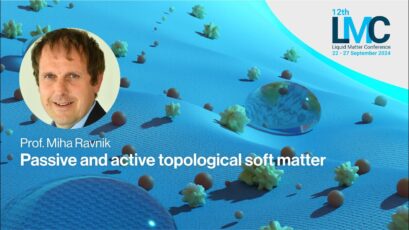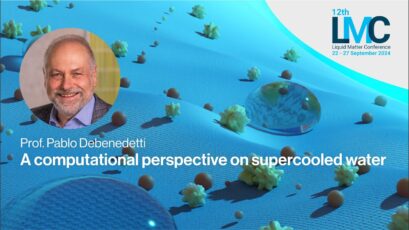
Das Video wird von Youtube eingebettet.
Es gelten die Datenschutzerklärungen von Google.
Liquid Matter
Freezing of drops | Detlef Lohse
Topic: Liquid interfaces, foams and emulsions
Speaker: Prof. Detlef Lohse, Physics of Fluids Department, Faculty of Science and Technology, University of Twente, Enschede, The Netherlands
An immersed soft particle or oil droplet is severely deformed when engulfed into an advancing ice front. This deformation strongly depends on the engulfment velocity, even forming pointy-tip shapes for low velocities. We found that such singular deformations are mediated by interfacial flows in nanometric thin liquid films separat-ing the nonsolidifying dispersed soft particles or droplets and the solidifying bulk. The competing forces in the thin film originate from the disjoining pressure and the surface tension gradient (Marangoni forces). We analytically modelled the fluid flow in these intervening thin films, using a lubrication approximation in the boundary layers. In an exact analytical calculation and with a formal analogy to a nonlinear pendulum, we then related the fluid flow to the deformation sustained by the dispersed droplet. We find it astounding that the nanoscopic interaction (van der Waals forces, disjoining pressure) determines the shape of the macroscopic immersed soft particle or droplet. This work has been published in reference [1].
We then extended this line of research to the interaction of several immersed soft particles or droplets over which a solidification front is passing. This time it is the relative thermal conductivity of the soft particles and the liquid which determines whether the two soft particles repel or attract. We call the effect the frozen Cheerios effect. Next, we identified a freezing-induced topological transition of a double-emulsion, i.e., an oil droplet with an immersed water droplet inside, and as a whole immersed in water, passing through a freezing front. Whether the water droplet inside the oil droplet survives or whether it literally bursts due to pressure forces emerging at solidification depends on the control parameters, in particular the freezing front velocity. Finally, we experimentally and numerically investigate the initial growth of gas bubbles that nucleate and grow near the advancing ice front. We show that the initial growth of these bubbles is governed by diffusion and is enhanced due to a combination of the presence of the background gas concentration gradient and the motion of the approaching front. Additionally, we recast the problem into that of mass transfer to a moving spherical object in a homogeneous concentration field, finding good agreement between our experimental data and the existing scaling relations for that latter problem.
The work in the subprojects of this line of research has partially also been done with Pallav Kant, Vincent Bertin, Christian Diddens, Duco van Buuren, Duarte Rocha, and Annemarie Linnenbank, all Physic of Fluids group, University of Twente.
Livestream der Plenar-Vorträge der 12. Liquid Matter Conference in Mainz vom 22. - 27. September 2024
Speaker: Prof. Detlef Lohse, Physics of Fluids Department, Faculty of Science and Technology, University of Twente, Enschede, The Netherlands
An immersed soft particle or oil droplet is severely deformed when engulfed into an advancing ice front. This deformation strongly depends on the engulfment velocity, even forming pointy-tip shapes for low velocities. We found that such singular deformations are mediated by interfacial flows in nanometric thin liquid films separat-ing the nonsolidifying dispersed soft particles or droplets and the solidifying bulk. The competing forces in the thin film originate from the disjoining pressure and the surface tension gradient (Marangoni forces). We analytically modelled the fluid flow in these intervening thin films, using a lubrication approximation in the boundary layers. In an exact analytical calculation and with a formal analogy to a nonlinear pendulum, we then related the fluid flow to the deformation sustained by the dispersed droplet. We find it astounding that the nanoscopic interaction (van der Waals forces, disjoining pressure) determines the shape of the macroscopic immersed soft particle or droplet. This work has been published in reference [1].
We then extended this line of research to the interaction of several immersed soft particles or droplets over which a solidification front is passing. This time it is the relative thermal conductivity of the soft particles and the liquid which determines whether the two soft particles repel or attract. We call the effect the frozen Cheerios effect. Next, we identified a freezing-induced topological transition of a double-emulsion, i.e., an oil droplet with an immersed water droplet inside, and as a whole immersed in water, passing through a freezing front. Whether the water droplet inside the oil droplet survives or whether it literally bursts due to pressure forces emerging at solidification depends on the control parameters, in particular the freezing front velocity. Finally, we experimentally and numerically investigate the initial growth of gas bubbles that nucleate and grow near the advancing ice front. We show that the initial growth of these bubbles is governed by diffusion and is enhanced due to a combination of the presence of the background gas concentration gradient and the motion of the approaching front. Additionally, we recast the problem into that of mass transfer to a moving spherical object in a homogeneous concentration field, finding good agreement between our experimental data and the existing scaling relations for that latter problem.
The work in the subprojects of this line of research has partially also been done with Pallav Kant, Vincent Bertin, Christian Diddens, Duco van Buuren, Duarte Rocha, and Annemarie Linnenbank, all Physic of Fluids group, University of Twente.
Livestream der Plenar-Vorträge der 12. Liquid Matter Conference in Mainz vom 22. - 27. September 2024
- Länge: 37m 22s
- Nächster Sendetermin: 10.05.2025 06:12 Uhr
- Produziert von: L. Herzog
Archiv


















